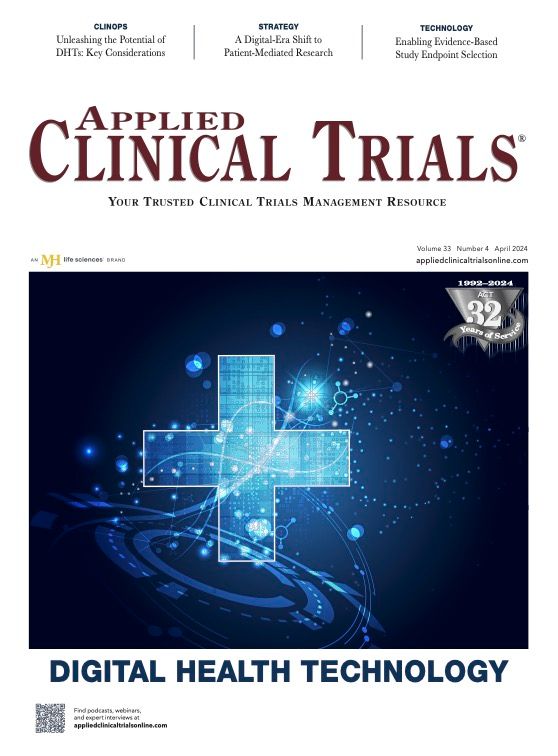Unleashing Their Potential: The Evolving Landscape of DHTs
Key considerations in deploying fit-for-purpose digital health technologies in drug development.



It’s no secret that digital health technologies (DHTs) are now commonplace in clinical trials and have grown exponentially over the past decade. Since the time of the paper-only years in the not-so-distant past, the industry has seen huge advancements in technology capabilities and a flood of new vendors and solutions. We work solely in DHT implementation and come with years of experience, but we run into new obstacles on every study. Despite the advancements, there are still many factors to consider for successfully deploying fit-for-purpose DHT solutions. This article will highlight some of the lesser-known considerations based on the recent FDA industry guidance “Digital Health Technologies for Remote Data Acquisition in Clinical Investigations.”
What is DHT?
First, let’s define DHT. DHT refers to a wide range of systems such as mobile applications for electronic clinical outcome assessments (eCOA), wearable devices for measuring activity, remote study participation tools such as televisit and eConsent, and remote diagnostic tools such as glucometers and blood pressure monitors. Including DHT in a study can provide a wide array of benefits, including enhanced participant engagement and compliance;1 expanded participant diversity; real-time data gathering and safety monitoring; financial savings; enhanced data quality; minimized environmental impact; and increased ease of use2 for participants and sites.
How do I choose a DHT vendor?
Incorporating DHT into a study has become a standard practice, but choosing the right vendor and fit-for-purpose technology can be overwhelming due to the broad array of options on the market. When selecting a vendor, it’s critical to consider both the vendor and the technology; key considerations include:
- Conduct a thorough vendor audit and capabilities check and ensure robust operational procedures.
- Ensure compliance with FDA 21 CFR part 11 regulations, including site and patient attribution, audit trails, and electronic signatures.
- Consider vendor service level commitment, whether it fits the study needs, and if a master service agreement is required.
- Consider past vendor experiences, vendor experience in the therapeutic area, preferred vendors, and strategic partnerships.
- In multi-solution studies, evaluate the feasibility of vendor consolidation to streamline technology, trainings, and access, while also discussing potential integrations and efficiencies (such as cost, timelines, and single sign-on) for consolidated platforms.
- Consider needed modalities (provisioned devices, web-based solutions, participant’s own device, or a combination).
- Confirm protocol-driven requirements needed in the trial platform are available (i.e., image capture, reporting, calculations, integrations, event-driven assessments, modalities).
- Ensure that the data flow is clearly defined and, if necessary, ensure that data corrections can be easily made in a manner that complies with regulations and allows for the identification and monitoring of incomplete, incorrect, or erroneous data.
- For decentralized studies, confirm the vendor can support remote administration capabilities such as virtual sites, televisits, and home healthcare.
Overlooked considerations in DHT selection and design
Participant-focused design has become the industry standard, but sponsors and contract research organizations (CROs) also should take into account lesser-known factors such as validating the technology for its intended use, particularly when supporting novel endpoints.
Is the technology or assessment being used in a way it’s never been used before?
If used in a new way or new modality:
- Talk with your vendor to initiate a usability study to test the product.
- Consider conducting an equivalency study3 between the electronic and paper versions or verify the accuracy of the measurement collected for non-COA technologies.
- Discuss plans for novel endpoint development with the relevant agency review division to ensure alignment and obtain any necessary guidance.
What characteristics of the study population and system functionality should be considered to ensure usability and engagement?
- Age, technical abilities, physical conditions (i.e., eyesight, dexterity) and cognitive-specific health conditions that could affect the use of the device (i.e., requiring larger buttons/font for visually impaired individuals).
- Confirm the device is user-friendly and, in the case of wearables, that it is comfortable to wear.
- Ensure that the device does not provide any feedback that could interfere with the participant’s interaction or potentially influence their responses.
- Verify that the system has the capability to include alerts and reminders to promote patient safety, compliance, and active engagement.
What hardware (device) requirements should be considered?
- Confirm percentage of participants that are expected to need provisioned devices. Best practice: Provide provisioned devices with cellular service in all DHT studies to prevent technology from impeding study enrollment, even if participants are expected to use their own devices.
- Confirm specific capabilities that may be necessary for the DHT, such as requiring a smartphone with up-to-date Bluetooth capabilities.
- Ensure that participants have sufficient network capacity to meet the data needs of the study.
- Determine the lifespan of the device and ensure that it will be supported throughout the duration of the study.
- Evaluate the battery life of the device and determine the charging frequency.
What should be included in the informed consent form?
You now know why DHT is critical to your study, but to ensure effective understanding and approval, it is essential to clearly define the solutions and hardware in the informed consent form (ICF) for the study. This will enable participants to understand the purpose and functionality of the technology, and investigators and regulators to comprehend how participants will interact with it. Here are some key points to consider when drafting the ICF:
- Explicitly describe the DHT and its use in the study. The ICF should provide a clear and concise explanation of what the DHT is, how it will be utilized in the study, and any known risks. It may be helpful to consult with your vendor and/or CRO for template language or guidance in describing the DHT.
- Ensure country-specific language is included. Collaborate with your CRO to gain insights into country-specific requirements, as certain regulatory agencies may require specific language regarding devices, data privacy, and modalities.
- Explain data collection, usage, and monitoring. The ICF should outline what type of data will be collected, how it will be used, and who will have access to the data. This information should be presented in a manner that is easily understood by the participant and assure participants that their privacy will be protected.
- Define steps for emergency medical care. In the event of concerning signs or symptoms in DHT (sensor/medical device) data, such as an abnormal cardiac rhythm, the ICF should clearly outline the steps that will be taken to follow-up and provide emergency medical care. This may include contacts that may be made to the participant, emergency medical services, or providing contact information for healthcare professionals involved in the study.
- Specify vendor/technology end-user license agreements and privacy policies. It is advisable to request and review the vendor or technology partner’s end-user license agreements and privacy policies. Thoroughly review these documents to fully understand the potential impact of the terms on participants and incorporate any pertinent information into the ICF.
Should study-specific DHT testing be performed?
After configuring your DHT, it’s important to plan for usability testing, commonly known as user acceptance testing (UAT), on the study-specific DHT system. This testing, conducted by a vendor-agnostic party such as the sponsor or CRO, involves detailed real-world scenario-based testing scripts. The level of testing required depends on the level of customization in the design, with out-of-the-box technologies typically requiring minimal testing to ensure compatibility with other study elements and successful data reception and transmission.
UAT is essential for DHT for two reasons:
- Confirming functionality. UAT allows for the verification of the DHT’s functionality, ensuring that it meets the specific needs and requirements of the study. It helps identify any bugs, errors, or usability issues that may hinder the proper functioning of the technology. Confirming functionality promotes higher adoption rates and compliance with the technology throughout the study, leading to more accurate and reliable data collection.
- Mitigating risks. Identifying and resolving issues during the UAT phase reduces the likelihood of encountering problems during the actual study. If there are multiple solutions or integrations systems (i.e., interactive voice response system, electronic data capture, eConsent), a full end-to-end UAT is advised to ensure a smooth integration. This saves both time and resources, as it minimizes the need for rework, system modifications, or delays in study deployment.
How do you ensure fit-for-purpose training?
As you approach DHT go-live, it’s time to think about how the end users will be trained and how support issues will be resolved. Training is a critical component of the DHT implementation process, ensuring comprehensive understanding of the DHT usage in the study among participants, sites, and study staff, as well as providing guidance for accessing support as required. In planning training materials, it’s important to remember that some content cannot be finalized until the DHT design is final and UAT is completed. This can be a barrier to submissions for participant-facing materials, so be sure to discuss these timelines with your regulatory teams.
Incorporate UAT findings. By incorporating UAT feedback into the creation of training materials, all identified usability concerns and findings can be effectively addressed and mitigated.
Focused training materials. To ensure clarity, participant materials should be concise and easy to understand. For site materials, it is advisable to explore training options beyond manual-based support, with live training sessions being highly recommended either at an investigators’ meeting or remotely during study start-up.
Create a quick reference guide. Creating a brief overview as a supplement to comprehensive manuals and training materials allows for swift troubleshooting and easy access to support when issues arise.
Define support and help-desk requirements:
- Confirm local language support is available for all languages.
- Ensure sites and participants know how to resolve common issues and that help-desk contact information is easily available. (i.e., adding help-desk support numbers as a sticker on a device).
- Outline process and timing for device replacements.
Summary/key takeaways
These lesser-known considerations will help to ensure successful DHT deployment in order to fully unleash its potential. Diligence and involvement in each step of the process are key, whether that is direct sponsor oversight or through CRO oversight, asking the right questions will decrease risk and ensure a successful DHT deployment.
- Vendor and technology selection are critical and should not be rushed. Beginning the process early and conducting thorough due diligence can have a significant positive impact on the overall outcome and validity of the study results.
- Clear ICF language is key to participants, sites, and agencies understanding DHT use and risks. The clarity of the language employed in the ICF is pivotal in ensuring a comprehensive understanding of the implications and potential risks related to the use of DHT.
- An end-user-focused approach (participant and site) should drive all aspects of DHT design. Prioritizing the needs, preferences, and usability requirements of the end-users is paramount to ensure a seamless and optimized experience using DHT throughout the study.
Conduct testing. By conducting UAT on the study-specific DHT system, we can mitigate potential risks, enhance user experience, validate compatibility, and validate the effectiveness of any customizations, ultimately contributing to the success of your study. - Training plays a vital role in ensuring a comprehensive understanding and providing ongoing support guidance throughout the study.
Jill Sommerville, Senior Director; Lauren Flood, Associate Director; and Matthew Ryan, Associate Director; all with the digital and decentralized solutions for the PPD clinical research business of Thermo Fisher Scientific
References
1. Stone, A.A.; Shiffman, S.; Schwartz, J.E.; Broderick, J.E.; Hufford, M.R. Patient Non-Compliance with Paper Diaries. BMJ. 2002. 324, 1193–1194. https://doi.org/10.1136/bmj.324.7347.1193
2. Greenwood, M.C.; Hakim, A.J.; Carson, E.; Doyle, D.V. Touch-Screen Computer Systems in the Rheumatology Clinic Offer a Reliable and User-Friendly Means of Collecting Quality-of-Life and Outcome Data from Patients with Rheumatoid Arthritis. Rheumatology (Oxford). 2006. 45 (1), 66–71. https://academic.oup.com/rheumatology/article/45/1/66/1788496
3. Gary, S.T.; Otero, A.; Faulkner, K.G.; Dias, N.R. Validation and Equivalency of Electronic Clinical Outcomes Assessment Systems. Int J Clin Trials. 2020. 7 (4), 271-277. https://www.ijclinicaltrials.com/index.php/ijct/article/view/439

Newsletter
Stay current in clinical research with Applied Clinical Trials, providing expert insights, regulatory updates, and practical strategies for successful clinical trial design and execution.
Effect of AI/ML, Real World Evidence and Master Protocols on Trial Success
July 7th 2025How the application of artificial intelligence, broader use of real-world evidence, decentralized clinical trials, master protocols, and risk-based quality monitoring, together with strong ethical oversight and increased collaboration, are contributing to better healthcare delivery and strengthening the role of clinical research in driving global health progress.
What Can ClinOps Learn from Pre-Clinical?
August 10th 2021Dr. Hanne Bak, Senior Vice President of Preclinical Manufacturing and Process Development at Regeneron speaks about her role at the company as well as their work with monoclonal antibodies, the regulatory side of manufacturing, and more.
Putting Collective Insights Into Action to Advance Cancer Care: Key Examples From ASCO 2025
June 27th 2025At ASCO 2025, clinical operations leaders gained critical insights into how AI tools, bispecific antibodies, and evolving treatment paradigms are reshaping trial design, endpoint selection, and patient stratification.
Beyond the Molecule: How Human-Centered Design Unlocks AI's Promise in Pharma
June 23rd 2025How human-centered AI that is focused on customer, user, and employee experience can drive real transformation in clinical trials and beyond by aligning intelligent technologies with the people who use them.